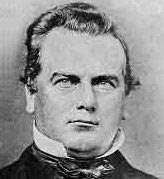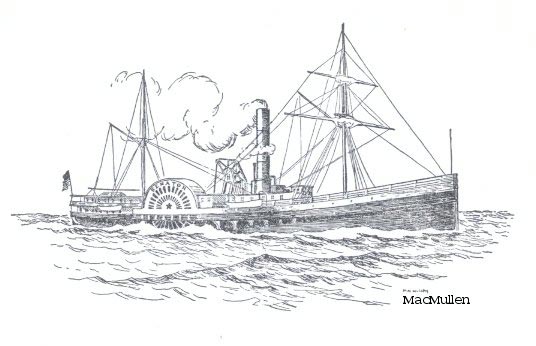|
Ship's |
Type |
Year |
Year |
Cause |
Owner |
Captain |
Length |
Beam |
Tonnage |
Engine |
County |
Ada |
Steam |
1859 |
1863 |
Explosion |
Gen. |
|
65 feet |
|
83 |
|
Los Angeles |
THE "ADA HANCOCK" DISASTER
Reprints from the Los Angeles Star of May 2, 1863.
Lost Gold of the Ada Hancock
By Land ~ Sea Discovery Group Staff
In the 1860's Los Angeles Harbor had but two docks and neither the docks nor the harbor entrance were large enough to accommodate the deep draft of coastal steamers. A man named Timms located in the town of San Pedro owned one of the docks and the other located in the town of Wilmington owned by General Phineas Banning. The latter was called Banning Dock. Banning had come to California from Delaware in 1851 and had set himself up in the freight and passenger business between his dock and Los Angeles. His dream was to develop San Pedro Harbor into the finest harbor on the west coast. The wreck of Ada Hancock almost cut his dream short.
For years the steamers had to anchor a mile offshore and row their cargo and passengers ashore. Banning put  Phineas Banning. together a small fleet of ships to alleviate this problem. One of these ships was the trim 65' Ada Hancock. This 85-ton double prop ship was once called the Milton Willis but a new coat of paint and its brass bright and shiny made it a proud member of the Banning Fleet. Ada Hancocks duties were to transport cargo and passengers out to the anchored steamers.
Phineas Banning. together a small fleet of ships to alleviate this problem. One of these ships was the trim 65' Ada Hancock. This 85-ton double prop ship was once called the Milton Willis but a new coat of paint and its brass bright and shiny made it a proud member of the Banning Fleet. Ada Hancocks duties were to transport cargo and passengers out to the anchored steamers.
On April 27, 1863 a coastal steamer named the Senator was anchored off Dead Man's Island in Wilmington Bay. The steamer was set to leave early that evening for San Francisco and was awaiting the arrival of its own Captain Seely who was on shore taking care of last minute details. Captain Seely had bumped into General Banning on shore and in the course of their conversation Seely agreed to assist in the transporting of a group of Bannings friends along with the other passengers to the deck of the Senator for a gala bon voyage party. Finally all were on board. Included on this last voyage were Captain Seely, General Banning and his family, many well-wishers for the party, and a Wells Fargo messenger named William Ritchie.

The ships papers, passengers' valuables, and the Wells Fargo messenger's gold were safely stored on the Ada Hancock's bridge for the short run out to the anchored Senator. Clouds hung over the harbor and it is said there was a chill in the air. The vessels lines were cast off and the ship had started to swing away from the pier when a late border ran up and demanded to be put on the ship. Some of the crew tossed out a line and by hand pulled the ship into the pier so the man could be boarded. Later a Mexican deck hand reported that the man was Louis Scheslinger, a man he knew well on the docks. The dockhand said that Scheslinger was very angry. It turns out that Louis Scheslinger was also a Wells Fargo messenger but not working at the time.
The Ada Hancock then turned away again and chugged its way out towards Dead Man's Island and the anchored Senator. About a thousand yards out, roughly half way to its destination the Ada Hancock suddenly blew up to the horror of all those who awaited her on the decks of the Senator. One of the passengers who saw the affair said that the ferry had cast off and then gone back in to pick up a passenger. When finally boarded the ship backed away from the dock and proceeded towards him. He watched for a short period of time and then he says he stepped back to let a crewmember pass and while his eyes were diverted he heard gunshots. When he looked again to the ship it exploded. Bodies and debris rose into the air as if in slow motion. One of the boilers had exploded, or was it the barrels of gunpowder that had been loaded on earlier that day and had not yet been off loaded. In either case the explosion blasted the deck house, wheel house, and valuables into the air and whatever didn't go straight up went forward through the crowd on the deck killing many of them including Captain Seely. General Banning and his family were thrown off the stern and injured but he lived long enough to realize a great portion of his dream for San Pedro Harbor.
After the explosion the ship sank right away. Bodies and flotsam were everywhere. A great wave rocked the Senator moments after the ship exploded.
When the Ada Hancock finally released its last gasp of air a huge bubble came up from its grave on the bottom of the bay. Twenty-six of the over fifty passengers were killed and all but two of the survivors were injured. It is also very unfortunate that around four in the afternoon, an hour before the explosion, the only communication between the waterfront towns and Los Angeles was a telegraph wire that was mysteriously cut at midway. Thus it was more then five hours before news reached Los Angeles. Luckily upon hearing the explosion, soldiers from nearby Camp Drum and others from the dock at San Pedro raced out in rowboats to pick up survivors. When they got there not much but debris remained. They gathered up the remaining survivors that had not been snatched up by the Senator and headed back to shore. They were then taken by wagon to Camp Drum where the camps medical officer attended them. When questioned most of the survivors agreed that there had been gunfire before the explosion but they could not agree whether it came from topside or below the decks. Many people also said the smell of gunpowder was heavy in the air after the explosion. Some said that the boiler had blown up. Much later a Banning employee said that the boiler was defective. Although it was a great tragedy, the Senator sailed for San Francisco that night.
The next day the news reached the Los Angeles office of Wells Fargo where they were very concerned due to Mr. Ritchies disappearance along with a $25,000 shipment of gold that was destined for the mint in San Francisco. An investigation was launched and it was found out that Ritchie was indeed on that fateful last voyage across the bay. In fact three days later his badly mangled body washed up on shore. An audit at the bank showed that Ritchie had indeed picked up the $25,000 shipment but unexpectedly there was an additional $100,000 worth of gold bullion missing. Wells' Fargo's gold reserves in Los Angeles had been wiped out! Investigators discovered Ritchie had met at least twice that day with Louis Scheslinger local loan shark and messenger for Wells Fargo. Scheslinger had in the days just prior to the 27th started selling off all his properties and loans discounting some as much as 50%.
On the morning of the 27th he withdrew his account with Wells Fargo in cash. Later in the day he was seen with Ritchie at a hotel and near the Wells Fargo office's, but then was not seen again until the deck hand saw him board the Ada Hancock. His body was never found. It was also noted that Ritchie had left on his assignment that afternoon from the Wells Fargo office by stage. The driver recalled there being three metal boxes all bearing the Wells Fargo seal. Officials say that one box was enough to hold the $25,000 shipment. In conclusion the folks at Wells Fargo deduced that Ritchie may have been trying to double-cross his partner Scheslinger in the bank theft and at the last minute he had been found out. The ensuing gun shots may have been caused by them battling it out on the decks of the Ada Hancock and in some way set off the explosion, causing the death of twenty six. $125,000 in gold went down to the bottom of the bay that day and was not recovered.
On old maps of the harbor area you can find the old Banning dock and Dead Man's Island. A mile off shore on a direct line between the two the wreck sits and waits. Both the dock and the Island are gone now. Dead Man's Island which at one time was a beacon for ships was dredged away in 1928 in order to widen the channel. The debris of the island was deposited along the jetty to Terminal Island. It was dredged to a depth of thirty-five feet. A good ocean chart or an old salt should put you in the right direction.
SOURCE DOCUMENTATION
1. Thomas Penfield, A GUIDE TO TREASURE IN CALIFORNIA, True Treasure Publications, 1972.
2. Brad Williams, Choral Pepper, LOST TREASURES OF THE WEST, Holt-Rinehart-Winston, 1975
3. Duncan Gleason, THE ISLANDS AND PORTS OF CALIFORNIA, The Devin Adair Co., 1958.
4. Don B. Marshall, CALIFORNIA SHIPWRECKS, Superior Publishing Company, 1978
Source: e-Adventure
THE ADA HANCOCK EXPLOSION
1863, April 27. A terrible tragedy took place in the harbor at San Pedro. It was the explosion of the Ada Hancock, a lighter owned by Phineas Banning. Banning himself was on board but blown clear of the water, landing on a sand bar.19 Among many prominent citizens injured or killed, it took the life of W.T.B. Sanford, Banning's brother-in-law. He had been the contractor who, with his partner George Carson, had made the first cut through the high rocks for the new San Fernando Pass nine years before. At the previous meeting of the Board of Supervisors, just a month earlier, he had been appointed with Francis Mellus, one of the commissioners to assess the toll for the new road. Now he would not see its completion.
Source:
The Santa Clarita Valley History
http://www.scvhistory.com/scvhistory/scvhistory.htm
* * * * * * * * * * * * * * * * * * * * * * * * * * * * * * * * * * * * * * * * * *
April 30. . . . .The steamer Senator arrived from Los Angeles with the remains of Capt. T. W. Seeley, and others, killed by the explosion on the Ada Hancock, in the bay of San Pedro, on the 27th . . . .
Source:
San Francisco History
Events of 1863
* * * * * * * * * * * * * * * * * * * * * * * * * * * * * * * * * * * * * * * * * *
1863
. . . . An explosion rips through the steamer Ada Hancock in Wilmington Harbor, killing 26 of the 53 passengers aboard. . . .
Source:
The Los Angeles Almanac
http://www.losangelesalmanac.com
* * * * * * * * * * * * * * * * * * * * * * * * * * * * * * * * * * * * * * * * * *
LAFIRE.COM
Copyright 2001 - All Rights Reserved